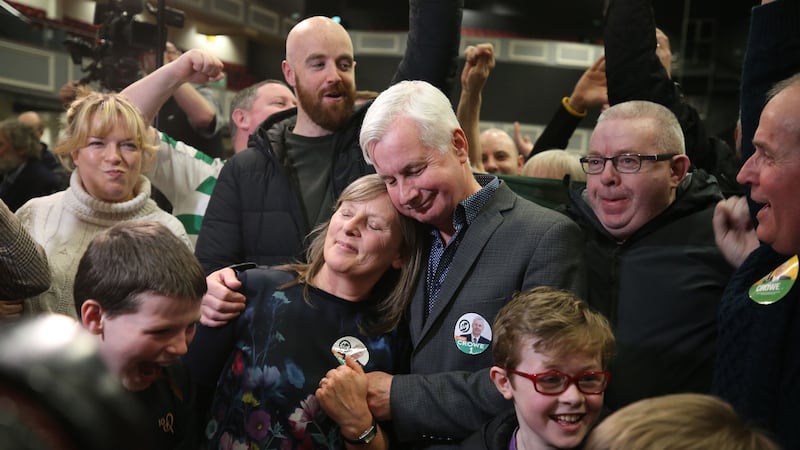Two years after she was elected Sinn Féin president, Mary Lou McDonald has wildly exceeded the expectations of party members who chose her to succeed Gerry Adams.
When the Dublin Central TD was elected party leader at a special ardfheis in the RDS, Dublin, on February 10th, 2018, those present hoped she could extend Sinn Féin's reach into the parts of the Irish electorate Adams could not touch.
It is unlikely party members thought her leadership would herald this level of success, which saw her walk through the front door of the same RDS on count day two years later as the star of Election 2020.

Sinn Féin is set for a seat haul in the mid to late 30s, a significant increase on the 22 seats it had when the 32nd Dáil was dissolved.
The feat is all the more remarkable for the fact McDonald has encountered setbacks in the two years since she succeeded Adams. Her first electoral outing was the 2018 presidential election, when Sinn Féin candidate Liadh Ní Riada came fourth on just 6.37 per cent of the vote.
That was followed by last year's local and European elections, which saw Sinn Féin drop from the 159 council seats it won in 2014 to 81 seats and lose two MEPs: Lynn Boylan in Dublin and Ní Riada in Ireland South.
The party, as it always does after elections, carried out a review. A view formed among some that Sinn Féin needed to strike a better balance between promoting its own policies and criticising the government.
The key frontbench spokespeople – Eoin Ó Broin in housing, Pearse Doherty in finance and Louise O'Reilly in health – came to the fore. Party sources also said TDs went back to their "bread and butter" of providing constituency services, which Sinn Féin sources claim outstrip those of other parties.
Fortunes turn
In the aftermath of the drubbing in the local elections, many in the party felt that some who lost their council seats had not done enough work on the ground. The same could not be said of the TDs.
The final months of 2019 saw the party's fortunes turn. Ó Broin engineered a byelection victory for Sinn Féin in his Dublin Mid-West constituency, with Mark Ward joining him in the Dáil and then holding the seat at the general election.
The Westminster elections last December were more mixed, with John Finucane taking the Belfast North seat held by the DUP's Nigel Dodds, as the Foyle seat was lost to SDLP leader Colum Eastwood.
The restoration of the Stormont institutions in January prevented Fianna Fáil, Fine Gael and others using the suspension of the Northern Ireland Executive against Sinn Féin during the general election campaign.

Confidence was returning, even if the expectation within the party was still that this general election would be about consolidating rather than expanding its Dáil numbers.
The fact that it decided to run only 42 candidates was evidence that Sinn Féin did not expect this level of success. It pruned tickets and left many TDs, including McDonald herself, without running mates, thus leaving seats behind.
Yet those who canvassed during the byelections said they felt something stirring among the electorate – a desire for change, and the identification of Sinn Féin as the party that could bring it about – which carried through to the general election.
"They were clear who they weren't voting for: Fianna Fáil, Fine Gael or Labour, " said one source of the attitude of party voters.
Best campaign
When the election came, Sinn Féin ran the best campaign of all the main parties, identifying the pension age issue at the outset and forcing RTÉ to change its mind and invite McDonald into the final leaders' debate.
Even though her performance in that debate was poor, party figures said her mere presence on the RTÉ set that night was enough. It said Sinn Féin was now on a par with Fianna Fáil and Fine Gael.
McDonald herself was the star of the campaign, and her repeated attacks on Fianna Fáil and Fine Gael for, as she claimed, being in power together for four years were brutally effective.
It robbed Micheál Martin of his claim to be an agent of change and solidified Sinn Féin as the party offering radical change.
McDonald herself was a hit on the canvass. In person, the Dublin Central TD is warm, friendly and approachable, and this came across in broadcast coverage of her daily walkabouts.
Those who dislike Sinn Féin are turned off by her strident Dáil and debate performances, and are unlikely to have been swayed during this campaign. But her stump appearances showed her warmth and ease with people.
Before she took over as leader, McDonald suggested her party should be prepared to enter government as a junior partner.
But she has brought Sinn Féin much further than being the new half in the old 2½-party system. She has firmly established it as the third force in Irish politics.









